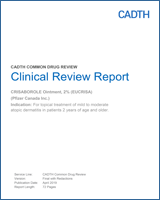Atopic dermatitis (AD) is a chronic, relapsing, and inflammatory skin condition, characterized by eczematous lesions, pruritus, and dry skin. Pruritus of the skin causes frequent scratching and may result in lichenification (thickening of the skin) and secondary skin infections. The symptoms of AD wax and wane and disease severity can range from mild to severe disease. AD begins in early childhood with the majority of cases beginning before the age of five years. Although childhood symptoms resolve by adolescence, some patients’ AD symptoms will persist or develop in adulthood. The Canadian Dermatology Association reported that the lifetime prevalence of AD is up to 17%, and there is evidence to suggest that the prevalence has increased over the past 30 years.
The goal of AD management is to prevent and manage flare-ups, which are recurrent episodes of worsening of symptoms that require an escalation of treatment. Although there is no cure for AD, there are several therapeutic options available to patients. The majority of patients treat AD using general skin care methods and topical anti-inflammatory therapies. However, if these practices fail to improve AD symptoms, patients may use off-label systemic immune-modulating agents or other therapies, such as phototherapy. The most commonly pharmaceutical topical therapies for patients with AD include topical corticosteroids (TCS) and topical calcineurin inhibitors (TCI). TCS are anti-inflammatory agents that act to control flare-ups and they are considered a first-line therapy for patients with AD. Side effects associated with long-term use of TCS include striae (stretch marks), petechiae (small red or purple spots), telangiectasia (small, dilated blood vessels on the surface of the skin), skin thinning, atrophy, and acne. On the other hand, TCI are steroid-free, anti-inflammatory, immunosuppressant agents. In Canada, TCIs are used in the second-line setting for patients who exhibit steroid phobia or where the use of steroids is not advisable. The most common adverse event associated with TCI therapy is application site–specific burning and irritation.
Crisaborole is a low-molecular-weight benzoxaborole, nonsteroidal, topical ointment. Crisaborole inhibits phosphodiesterase type 4 (PDE4), which regulates inflammatory cytokine production. It is applied in a thin layer to the affected area, twice daily.
The current CADTH Common Drug Review (CDR) submission for crisaborole is for the treatment of patients two years of age and older with mild-to-moderate AD.
Version: Final with Redactions
Funding: CADTH receives funding from Canada’s federal, provincial, and territorial governments, with the exception of Quebec.
Disclaimer: The information in this document is intended to help Canadian health care decision-makers, health care professionals, health systems leaders, and policy-makers make well-informed decisions and thereby improve the quality of health care services. While patients and others may access this document, the document is made available for informational purposes only and no representations or warranties are made with respect to its fitness for any particular purpose. The information in this document should not be used as a substitute for professional medical advice or as a substitute for the application of clinical judgment in respect of the care of a particular patient or other professional judgment in any decision-making process. The Canadian Agency for Drugs and Technologies in Health (CADTH) does not endorse any information, drugs, therapies, treatments, products, processes, or services.
While care has been taken to ensure that the information prepared by CADTH in this document is accurate, complete, and up-to-date as at the applicable date the material was first published by CADTH, CADTH does not make any guarantees to that effect. CADTH does not guarantee and is not responsible for the quality, currency, propriety, accuracy, or reasonableness of any statements, information, or conclusions contained in any third-party materials used in preparing this document. The views and opinions of third parties published in this document do not necessarily state or reflect those of CADTH.
CADTH is not responsible for any errors, omissions, injury, loss, or damage arising from or relating to the use (or misuse) of any information, statements, or conclusions contained in or implied by the contents of this document or any of the source materials.
This document may contain links to third-party websites. CADTH does not have control over the content of such sites. Use of third-party sites is governed by the third-party website owners’ own terms and conditions set out for such sites. CADTH does not make any guarantee with respect to any information contained on such third-party sites and CADTH is not responsible for any injury, loss, or damage suffered as a result of using such third-party sites. CADTH has no responsibility for the collection, use, and disclosure of personal information by third-party sites.
Subject to the aforementioned limitations, the views expressed herein are those of CADTH and do not necessarily represent the views of Canada’s federal, provincial, or territorial governments or any third party supplier of information.
This document is prepared and intended for use in the context of the Canadian health care system. The use of this document outside of Canada is done so at the user’s own risk.
This disclaimer and any questions or matters of any nature arising from or relating to the content or use (or misuse) of this document will be governed by and interpreted in accordance with the laws of the Province of Ontario and the laws of Canada applicable therein, and all proceedings shall be subject to the exclusive jurisdiction of the courts of the Province of Ontario, Canada.

